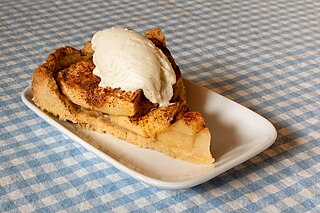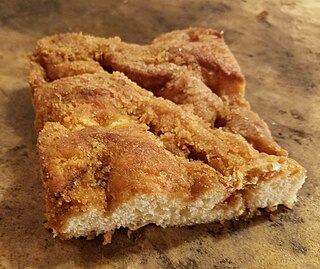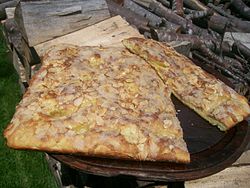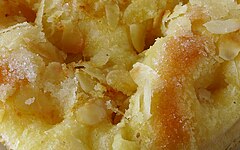
Cake is a flour confection made from flour, sugar, and other ingredients and is usually baked. In their oldest forms, cakes were modifications of bread, but cakes now cover a wide range of preparations that can be simple or elaborate and which share features with desserts such as pastries, meringues, custards, and pies.

Pound cake is a type of cake traditionally made with a pound of each of four ingredients: flour, butter, eggs, and sugar. Pound cakes are generally baked in either a loaf pan or a Bundt mold. They are sometimes served either dusted with powdered sugar, lightly glazed, or with a coat of icing.

A macaroon is a small cake or cookie, originally made from ground almonds, egg whites, and sugar, and now often with coconut or other nuts. They may also include jam or chocolate or other flavorings.

Gooey butter cake is a type of cake traditionally made in St. Louis, Missouri. It is a flat and dense cake made with wheat cake flour, butter, sugar, and eggs, typically near an inch tall, and dusted with powdered sugar. While sweet and rich, it is somewhat firm, and is able to be cut into pieces similarly to a brownie. Gooey butter cake is generally served as a type of coffee cake and not as a formal dessert cake. There are two distinct variants of the cake: the original St. Louis, MO Bakers' gooey butter and a cream cheese and commercial yellow cake mix variant. The original St. Louis, MO Bakers' gooey butter is believed to have originated in the 1930s. It was made with a yeast-raised sweet dough on the bottom.

Apple cakes are cakes in which apples feature as a main flavour and ingredient. Such cakes incorporate apples in a variety of forms, including diced, pureed, or stewed, and can include common additions like raisins, nuts, and 'sweet' spices such as cinnamon or nutmeg. They are a common and popular dessert worldwide, thanks to millennia of apple cultivation in Asia and Europe, and their widespread introduction and propagation throughout the Americas during the Columbian Exchange and colonisation. As a result, apple desserts, including cakes, have a huge number of variations.

Torta caprese is a flourless Italian cake made with chocolate and either almonds or hazelnuts. Named for the island of Capri from which it originates, the cake is widely known and especially popular in nearby Naples, Italy.

Streuselkuchen, also known in English-speaking countries as crumb cake, is a cake made of yeast dough covered with a sweet crumb topping referred to as streusel. The main ingredients for the crumbs are sugar, butter, and flour, which are mixed at a 1:1:2 ratio. The recipe allegedly originated in the region of Silesia, and is popular in German, Polish and Ashkenazi Jewish cuisines.

A sheet cake or slab cake is a cake baked in a large, flat, rectangular cake pan. Sheet cakes can be grouped into two broad categories.

Cardamom breads, including the Finnish pulla and Swedish kardemummabröd and kardemummabullar, are a group of enriched breads or pastry flavored with cardamom. They are eaten throughout the year, typically with coffee or tea.

Jumbles are simple butter cookies made with a basic recipe of flour, sugar, eggs, and butter. They can be flavored with vanilla, anise, or caraway seed used for flavoring, or other flavoring can be used like almond. They were formerly often made in the form of rings or rolls.

Kürtőskalács is a spit cake specific to Hungarians from Transylvania, more specifically the Székelys. Originally popular in the Székely Land, it became popular in both Hungary and Romania. The first written record dates back to 1679 and was found in the village of Úzdiszentpéter, while the first recipe appears in a manuscript cookbook dated in 1781. Earlier a festive treat, now it is part of everyday consumption. In Transylvania, a similar pastry to Kürtőskalács is Baumstriezel, originating in the Saxon communities.

A rock cake, also called a rock bun, is a small cake with a rough surface resembling a rock. They were promoted by the British Ministry of Food during the Second World War since they require fewer eggs and less sugar than ordinary cakes, an important savings in a time of strict rationing. Traditional recipes bulked them with oatmeal, which was more readily available than white flour.

A Franzbrötchen is a small, sweet pastry baked with butter and cinnamon, similar to a cinnamon roll. Sometimes other ingredients are used as well, such as chocolate or raisins. It is a type of pastry commonly found in northern Germany, especially Hamburg, and it is usually served for breakfast, but is also enjoyed along with coffee and cake. As its name indicates, the Franzbrötchen was probably inspired by French pastries. Originally, it could be found only in the region of Hamburg, but now Franzbrötchen are also sold in Bremen, Berlin, and other German cities.

Bienenstich or bee sting cake is a German dessert cake made of a sweet yeast dough with a baked-on topping of caramelized almonds and filled with vanilla custard, buttercream or cream. The earliest German and Swiss recipes for the cake date to the beginning of the 20th century. The dairy cream and custard filling would have required cool storage, inaccessible to most households in earlier centuries.

Eierschecke is a confectionery speciality from Saxony and Thuringia. It is a layer cake with a base layer of cake, a middle layer of quark-based cheesecake and a top layer of vanilla custard. Parts of it are covered with a glaze made of cream, whole egg, sugar and flour for thickening. The term originates from a piece of 14th century menswear called Schecke which consisted of a medium-length tunic with a very tight waistline and was worn with a Dusing, a hip belt. The cake was named after the appearance of this "tripartite garment".

Swabian cuisine is native to Swabia, a region in southwestern Germany comprising great parts of Württemberg and the Bavarian part of Swabia. Swabian cuisine has a reputation for being rustic, but rich and hearty. Fresh egg pastas, soups, and sausages are among Swabia's best-known types of dishes, and Swabian cuisine tends to require broths or sauces; dishes are rarely "dry".

Moravian sugar cake is a sweet coffee cake that is often made in areas around Moravian Church settlements, particularly in Pennsylvania and North Carolina. It is made with a sweet yeast dough enriched with mashed potatoes. The dough is left to rise in a flat pan, and just before baking, deep wells are formed in the surface of the dough with the finger tips, and a mixture of melted butter, brown sugar, and cinnamon is poured on top. During baking, this forms a rich sugary crust that permeates deep into the interior of the cake. Moravian sugar cake is best served warm from the oven, but it keeps at room temperature for several days, and also freezes well.





















